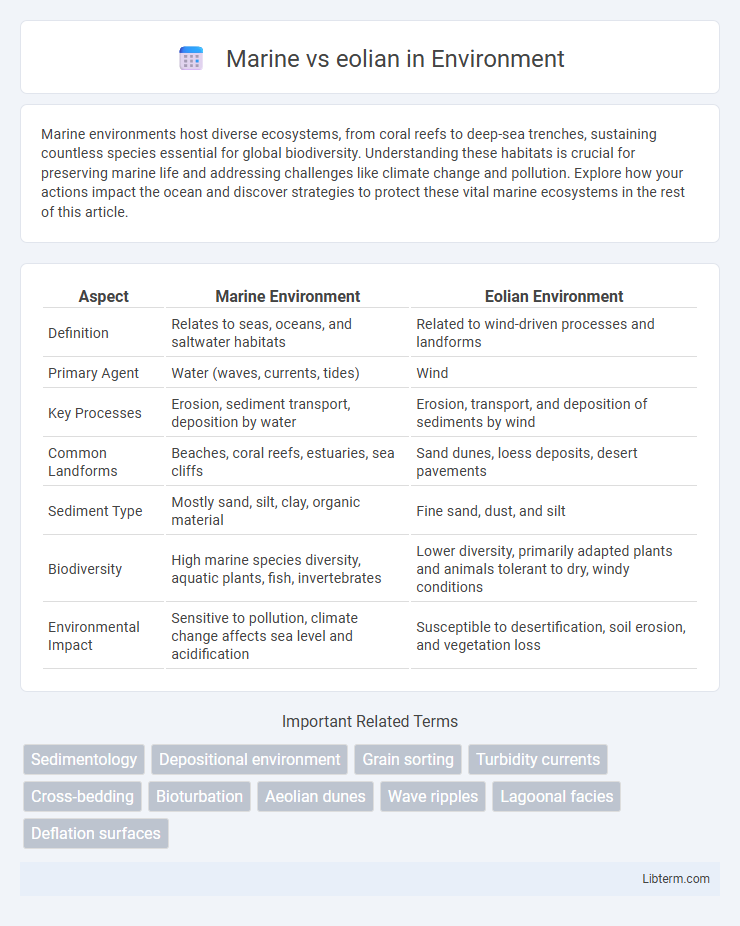Marine environments host diverse ecosystems, from coral reefs to deep-sea trenches, sustaining countless species essential for global biodiversity. Understanding these habitats is crucial for preserving marine life and addressing challenges like climate change and pollution. Explore how your actions impact the ocean and discover strategies to protect these vital marine ecosystems in the rest of this article.
Table of Comparison
| Aspect | Marine Environment | Eolian Environment |
|---|---|---|
| Definition | Relates to seas, oceans, and saltwater habitats | Related to wind-driven processes and landforms |
| Primary Agent | Water (waves, currents, tides) | Wind |
| Key Processes | Erosion, sediment transport, deposition by water | Erosion, transport, and deposition of sediments by wind |
| Common Landforms | Beaches, coral reefs, estuaries, sea cliffs | Sand dunes, loess deposits, desert pavements |
| Sediment Type | Mostly sand, silt, clay, organic material | Fine sand, dust, and silt |
| Biodiversity | High marine species diversity, aquatic plants, fish, invertebrates | Lower diversity, primarily adapted plants and animals tolerant to dry, windy conditions |
| Environmental Impact | Sensitive to pollution, climate change affects sea level and acidification | Susceptible to desertification, soil erosion, and vegetation loss |
Introduction: Marine vs Eolian Environments
Marine environments consist of saltwater ecosystems such as oceans, seas, and coastal areas characterized by wave action, tidal currents, and marine sediment deposition. Eolian environments are dominated by wind-driven processes affecting arid and semi-arid landscapes, resulting in the formation of dunes, loess deposits, and desert pavements. Understanding the distinct sedimentary structures and depositional patterns in marine versus eolian settings is crucial for geological and environmental studies.
Key Characteristics of Marine Processes
Marine processes primarily involve the action of ocean waves, tides, and currents shaping coastal landscapes through erosion, transportation, and deposition of sediments. The key characteristics include the formation of features such as beaches, estuaries, and deltas, driven by saltwater influence and tidal rhythms. These processes contrast with eolian dynamics, which are dominated by wind-driven sediment transport in arid or semi-arid environments.
Key Characteristics of Eolian Processes
Eolian processes are primarily driven by wind erosion, transportation, and deposition, forming distinctive landforms such as dunes, loess deposits, and sand sheets in arid and semi-arid environments. These processes are characterized by saltation, suspension, and creep of sediment particles, with particle size typically ranging from fine sand to silt, influenced by wind velocity and surface roughness. Unlike marine processes dominated by water, eolian dynamics create well-sorted sediments with unique cross-bedding structures essential for interpreting paleoclimates and sedimentary environments.
Sediment Types in Marine vs Eolian Settings
Marine sediments predominantly consist of fine-grained clays, silts, and biogenic carbonates derived from marine organisms, whereas eolian sediments are primarily composed of well-sorted sands and silts transported by wind. Marine environments favor the deposition of calcareous and siliceous ooze, while eolian settings often accumulate quartz-rich dunes and loess deposits. The granulometry and mineral composition in marine sediments reflect aqueous sorting and biological input, contrasting with the mechanical weathering and aerodynamic sorting characteristic of eolian sediments.
Transport Mechanisms: Water vs Wind
Marine transport mechanisms rely on the movement of water through waves, tides, and currents to carry sediments, enabling the sorting of particles based on size and density. Eolian transport, dominated by wind energy, moves fine particles such as sand and dust through processes like saltation, suspension, and surface creep, favoring well-sorted and angular sediments. Differences in medium density lead marine transport to typically move larger, more rounded particles, while eolian transport efficiently transports finer, more angular grains across arid landscapes.
Sedimentary Structures: Oceanic vs Desert Features
Marine sedimentary structures predominantly exhibit features such as ripple marks, graded bedding, and bioturbation formed by water currents and tidal influences in oceanic environments. Eolian sedimentary structures typically include large-scale cross-bedding, well-sorted sand grains, and surface crusts shaped by wind-driven processes in desert settings. Oceanic features often show evidence of continuous sedimentation and marine fauna activity, while desert deposits emphasize wind abrasion, dune migration, and intermittent sedimentary layering.
Fossil Records and Biological Activity
Marine fossil records reveal diverse, well-preserved assemblages due to sedimentary environments rich in organic material, supporting extensive biological activity and rapid burial. Eolian deposits often contain sparse fossilization primarily of hardy microorganisms or terrestrial plants, reflecting limited biological activity and exposure to harsh conditions. The disparity in fossil records highlights marine settings as hotspots for paleontological data, contrasted with the more fragmentary biological signatures in eolian contexts.
Geographical Distribution and Examples
Marine sediments predominantly accumulate along continental shelves, ocean basins, and deep-sea environments, with notable examples including the sedimentary deposits of the Atlantic continental margin and the Red Sea basin. Eolian sediments are primarily distributed in arid and semi-arid regions, such as the Sahara Desert, the Arabian Peninsula, and the Great Basin in the United States, characterized by wind-blown sand dunes and loess deposits. The distinct geographical distribution of marine sediments near water bodies contrasts with the widespread inland occurrence of eolian deposits shaped by prevailing wind patterns.
Impacts on Landform Development
Marine processes significantly shape coastal landforms through wave action, tides, and sediment deposition, creating features such as beaches, cliffs, and estuaries. Eolian forces mold arid and semi-arid landscapes by wind erosion, transportation, and deposition of sand and dust, forming dunes, loess plains, and deflation hollows. The interplay between marine and eolian dynamics influences sediment distribution and landform evolution in coastal and desert-margin environments.
Comparing Environmental Significance
Marine environments play a crucial role in regulating climate by storing vast amounts of carbon dioxide and supporting diverse ecosystems that sustain global biodiversity. Eolian processes, driven by wind activity in arid and semi-arid regions, significantly influence soil erosion, dust transport, and nutrient redistribution, affecting terrestrial ecosystem health and atmospheric conditions. Comparing their environmental significance reveals marine systems as critical carbon sinks with direct climate regulation impacts, while eolian systems primarily shape landforms and atmospheric particle distribution with indirect effects on climate and ecosystems.
Marine Infographic

 libterm.com
libterm.com